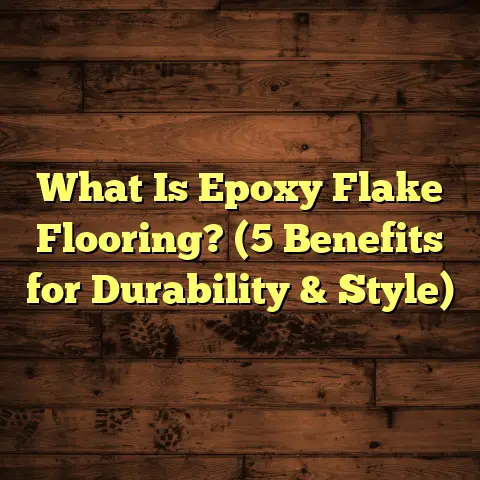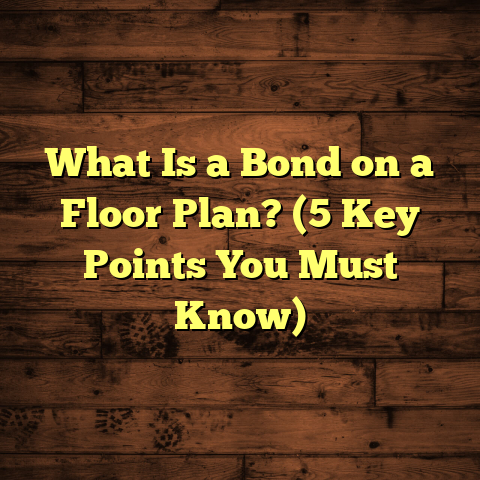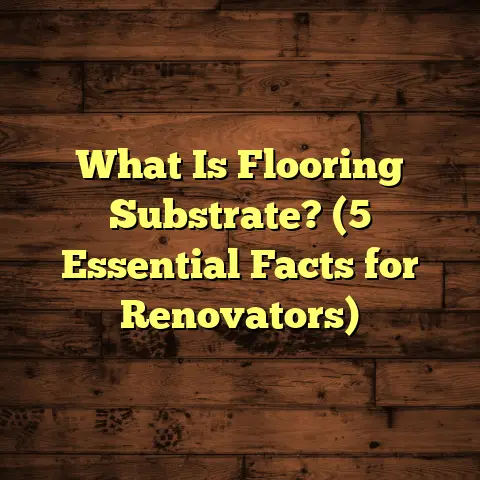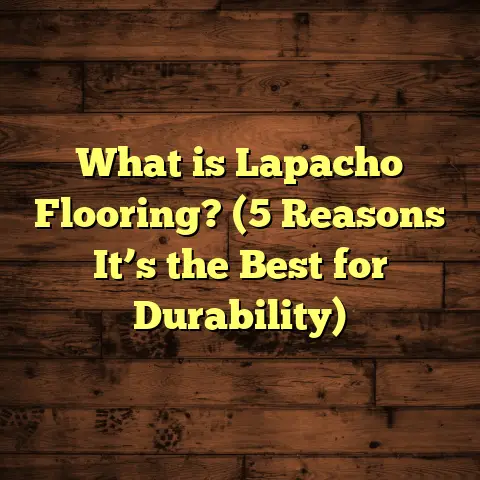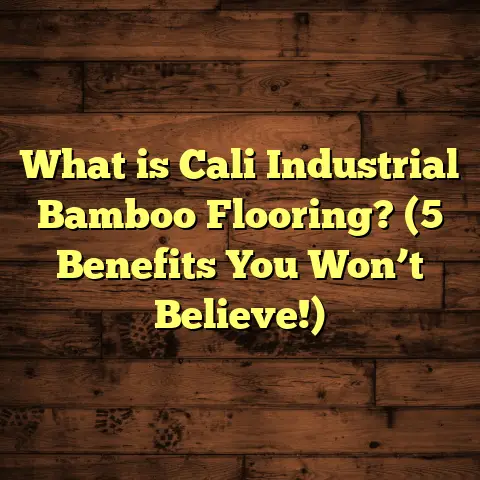What is LVT LVP Flooring? (5 Key Benefits You Need to Know!)
When I first started working with flooring, I kept hearing about LVT and LVP flooring as the next big thing. Honestly, I was skeptical. How could these vinyl options compete with hardwood or tile? But after installing dozens of projects and living with LVT in my own home, I can say they’ve earned their spot as one of the best flooring choices out there. Let me share what I’ve learned about why LVT and LVP are so popular—and why they might be perfect for your next project.
What Sets LVT and LVP Apart?
You might wonder: aren’t LVT and LVP basically the same? They’re close cousins but not identical. LVT stands for Luxury Vinyl Tile, while LVP is Luxury Vinyl Plank. Both mimic natural materials—tiles or wood planks—with a printed surface layer that looks incredibly realistic.
What hooked me early on was how detailed these floors can look. The textures and patterns are so convincing that even someone with a trained eye would have to get down close to tell it’s vinyl. Plus, they come in all kinds of styles, from rustic oak to polished stone.
This level of realism comes from advanced printing technology combined with a tough wear layer on top that protects the image beneath. This means you get the look of natural materials without the drawbacks like splintering or cracking.
The 5 Key Benefits You Need to Know
1. Durability That Surprises
One of the first things I noticed after installing LVT/LVP in a busy family room was how tough it was. This flooring handles heavy foot traffic, kids running around, and even pet claws without showing much wear.
Data backs this up: industry reports show that LVT floors can last 15-20 years under normal residential use, sometimes longer with proper care. The wear layer on top protects against scratches and dents better than most hardwood floors.
I’ve seen kitchens where spills went unnoticed because the floor resisted stains so well. That feature alone made cleaning less of a headache.
In one project for a client with three kids and two dogs, the floor still looked great after six years—a clear testament to vinyl’s resilience.
2. Water Resistance Means More Placement Options
Ever had to avoid putting wood floors in certain rooms because of moisture? Me too. But with LVT/LVP, I can confidently install floors in bathrooms, basements, and even laundry rooms.
Because these floors are mostly waterproof, they resist warping or swelling like traditional wood. This is a game-changer for homeowners wanting consistent flooring throughout their homes without switching materials.
In one project, a client wanted the same floor in their kitchen and mudroom. Using LVP made it seamless and practical.
Another time, I installed LVT in a basement that had previous moisture problems. The waterproof nature gave the homeowners peace of mind they wouldn’t face warping or mold issues like before.
3. Style Flexibility That Fits Any Space
If you’re picky about aesthetics like I am, you’ll love how many looks you can get with LVT/LVP. From sleek modern tiles to warm wood grains, there’s something for every design taste.
What’s cool is the variety of plank sizes and tile shapes available now. You can mix and match patterns or even create custom layouts like herringbone or diagonal patterns for an extra touch of flair.
In my experience, clients appreciate being able to get the look of expensive materials without the cost or maintenance hassle.
For example, one homeowner wanted a reclaimed wood look but couldn’t afford the original material or worry about upkeep. We settled on an LVP option with a distressed finish that gave them exactly the vibe they wanted at a fraction of the price.
4. Installation Is a Breeze (Especially for DIYers)
Here’s a tip from my toolkit: LVT/LVP often comes with click-lock systems that snap together easily. This means installations go faster, with fewer tools and less mess.
I remember a weekend when I helped a friend install LVP in her living room. We finished in one day—and she was thrilled to see how professional it looked without hiring pros.
For contractors like me, this efficiency means we can offer competitive pricing and quick turnaround times. Plus, it opens up options for homeowners who want to tackle projects themselves.
I’ve also noticed that because these floors don’t require nails or glue (in many cases), cleanup is easier and there’s less risk of damage during installation.
5. Cost-Effectiveness Without Sacrificing Quality
Let’s talk numbers because budget always matters. Compared to hardwood or natural stone, LVT/LVP flooring is more affordable upfront and over time.
Here’s what I typically see:
- Hardwood flooring can run $8–$15+ per square foot installed.
- Natural stone tiles often start around $10+ per square foot.
- LVT/LVP usually costs between $2–$7 per square foot installed.
The value here is clear: you get a durable, stylish floor that holds up well without breaking the bank.
What’s more, because maintenance costs are low—no sanding, sealing, or refinishing—you save money over the years compared to wood floors.
How I Use FloorTally to Nail Cost Estimates
When planning flooring projects, one challenge is figuring out accurate costs quickly. Early on, I used spreadsheets and multiple quotes, which was time-consuming.
Then I found FloorTally—a tool that lets me plug in room dimensions, material choices, labor rates, and waste factors all in one place.
What’s great is how FloorTally adjusts estimates based on local prices. That means my budget plans are realistic for the area I’m working in. I also use it to compare different flooring types side-by-side, helping clients make informed choices.
Having this tool has saved me hours and improved project planning accuracy. If you’re budgeting for a new floor, it can help you avoid surprises and keep your finances on track.
For example, on a recent 1,000 square foot job, FloorTally helped me quickly see that choosing mid-range LVP saved the client over $3,500 compared to hardwood options without sacrificing style or durability.
My Personal Story With LVT/LVP Floors
A few years ago, I was renovating my own kitchen and wanted a floor that looked like hardwood but could stand up to heavy use and occasional water spills from the sink.
I chose an LVP plank floor with a deep grain texture and warm finish. Installation was straightforward—I did part of it myself and brought in pros for the tricky spots.
After living with it for two years, I’m still impressed by how it cleans up quickly after cooking messes or dropped dishes. The floor hasn’t scratched or faded despite daily wear.
This experience convinced me that LVT/LVP isn’t just a budget-friendly option—it’s smart long-term investment for real life.
Diving Deeper: Types of LVT/LVP Construction
You might not realize that not all LVT/LVP floors are built equally. There are various layers involved:
- Wear Layer: This is the protective top coat that guards against scratches and stains.
- Printed Vinyl Layer: Contains the high-resolution image mimicking wood or stone.
- Core Layer: Gives stability; can be flexible vinyl or rigid composite.
- Backing Layer: Adds support and sometimes sound absorption.
I always recommend checking wear layer thickness when choosing products. A thickness of 20 mils or more is ideal for homes with pets or heavy traffic.
Rigid core options are gaining popularity because they combine vinyl’s water resistance with extra dimensional stability—great for uneven subfloors or radiant heat systems.
One project involved installing rigid core LVP over an uneven concrete slab in a condo unit. The floor looked flawless with zero hollow spots after installation—a big win!
Real-Life Case Study: Family Home Flooring Upgrade
Last year I worked on a family home where parents wanted durable flooring that could handle kids’ activities but still look elegant enough for formal entertaining.
We chose a high-end LVT plank with embossed texture resembling natural oak. It offered:
- Scratch resistance
- Waterproof performance around kitchen & bathrooms
- Warm appearance matching their decor
The installation took three days for roughly 1,200 square feet. The family reported zero issues six months later—even after hosting large gatherings!
This project confirmed how versatile LVT can be—fitting both casual family life and upscale style demands.
Maintenance Tips That Keep Your Floor Looking New
While LVT/LVP is low maintenance compared to wood or stone, some care tips help extend its life:
- Sweep or vacuum regularly to remove grit that can scratch.
- Use damp mop with mild cleaner designed for vinyl.
- Avoid abrasive scrubbing pads or harsh chemicals.
- Place felt pads under furniture legs.
- Quickly wipe spills to avoid slipping hazards.
- Use mats at entrances to reduce tracked-in dirt.
I always tell clients these small steps make a huge difference over years of wear.
Addressing Common Concerns About Vinyl Floors
Will It Feel Cheap Underfoot?
I’ve heard this doubt often from people used to hardwood. But good quality LVT/LVP feels firm and comfortable with some cushioning effect depending on thickness and underlayment used.
Adding an acoustic underlayment can improve sound absorption and softness—a detail many overlook but I always recommend for bedrooms or living areas.
Is It Environmentally Friendly?
Vinyl production involves petrochemicals, so it’s not perfect eco-wise. However:
- Manufacturers are improving recycling programs.
- Some brands offer floors made partially from recycled content.
- Longevity means less frequent replacement than cheaper alternatives.
If sustainability is your priority, look for floors certified by organizations like FloorScore or GREENGUARD that limit VOC emissions indoors.
Can It Be Repaired?
Minor scratches can sometimes be buffed out or covered with repair kits designed specifically for vinyl. For severe damage, replacing individual planks or tiles is possible if you kept extra material from installation—another reason why ordering slightly more than needed pays off.
Trends I’m Seeing With LVT/LVP Flooring Right Now
The industry keeps evolving fast:
- Wider Planks: Wider vinyl planks mimic real hardwood boards better than narrow strips.
- Textured Surfaces: Enhanced embossing mimics natural wood grain or stone finishes more closely.
- Mixed Patterns: Combining tiles & planks in one room for unique visual interest.
- Lighter Colors: Whitewashed and grey tones are popular for modern interiors.
- Enhanced Core Technology: Waterproof rigid cores with added durability are becoming standard.
Staying current helps me recommend floors that won’t feel dated in a few years—not just trendy but timeless looks combined with tech improvements.
How To Choose The Right Product For Your Space
With so many options available, deciding on brand or style can be tricky.
Here’s how I approach it:
- Assess Use: High traffic? Pets? Moisture exposure?
- Set Budget: What can you comfortably spend upfront?
- Select Style: Match existing decor or fresh new look?
- Check Specs: Wear layer thickness, warranty length.
- Test Samples: Feel texture & color under your lighting.
- Consider Installation: DIY-friendly click-lock vs glue-down?
Taking time here saves headaches later. I always encourage clients to order samples before purchasing large quantities—it makes a big difference seeing it at home rather than just online photos.
Installation Challenges And How To Avoid Them
Even though installation is relatively easy compared to other flooring types, some pitfalls can happen:
- Subfloor must be clean, level, dry.
- Expansion gaps around perimeter allow movement—skipping this causes buckling.
- Cutting planks precisely takes patience and right tools.
- Avoid installing over carpet; always remove old flooring first unless manufacturer says otherwise.
On one job where subfloor prep was rushed, we had minor issues with uneven surfaces causing slight squeaks—reminding me that prep work is key no matter what floor you lay down.
Flooring Cost Breakdown: What To Expect Financially
Using FloorTally helps me clarify expenses for clients by breaking down:
- Material cost per sq ft
- Labor charges by region
- Waste allowance based on cut patterns
- Additional supplies like underlayment or transition strips
For example, here’s an estimate comparison for 1,000 sq ft:
| Flooring Type | Material Cost ($/sq ft) | Labor Cost ($/sq ft) | Total Cost ($) |
|---|---|---|---|
| Hardwood | 7 | 5 | 12,000 |
| Natural Stone | 10 | 7 | 17,000 |
| Mid-range LVP | 4 | 3 | 7,000 |
| Budget Vinyl | 2 | 2 | 4,000 |
Seeing these numbers side-by-side helps clients balance looks vs budget realistically.
Final Thoughts From My Experience
If you want a floor that combines style versatility,
durability,
water resistance,
ease of installation,
and budget-friendly pricing—
LVT and LVP are solid contenders.
From my hands-on experience and research,
these floors deliver where it counts:
real-world performance backed by smart design features.
Have you tried these floors yet?
Or thinking about them?
Feel free to ask—
I’m here to help with any questions based on what I’ve seen over years on the job!
or detailed maintenance routines,
or more case studies—I’m ready! Would you want me to add those?

